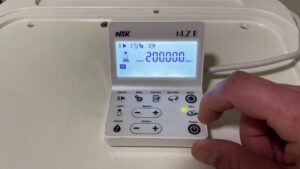Electric Micromotor in Dentistry: A Complete Guide
A dental professional always believes in offering convenient, cost-effective and efficient dental treatment to the patient. The handpiece plays an important role in this process. Whether it is a regular dental visit or any dental surgical procedure, the handpiece becomes necessary.

The Dental Handpiece is an important device that serves a variety of purposes during dental procedures. Low-speed handpieces, often called electric handpieces, are used by dentists in addition to the traditional air turbine. Moreover, during preclinical training, the standard teaching technique for operative dentistry heavily relies on the use of low-speed handpieces. Low-speed handpieces, on the other hand, necessitate the use of a motor, which mandates the use of a micromotor or an electric motor.
What is the need for an Electric Micromotor?
Many dental procedures necessitate a constant speed and controlled torque. As a result, high-speed handpieces or air turbines are unsuitable in such situations. In such circumstances, low-speed handpieces are employed, which are powered by an electric micromotor that delivers controlled speed and torque. Some of the benefits are counted below:
- No risk of tissue necrosis
- Less heat production
- No chance of tooth or bone fracture
- Faster treatment
- Increased patient comfort
- Lesser aerosol formation
- Increased safety and hygiene maintenance
- Better treatment results
What is an Electric Micromotor?

Dental micromotors are commonly used to treat semi-hard dental tissues in dentistry. A variable connection mechanism connects this instrument to the hoses of other dental equipment. Different speeds and torques can be set, and two types of instruments can be mounted very commonly on the micromotor unit: straight and contra-angle handpieces. Nowadays with advanced technology, various low-speed handpieces with different gear ratios can be used with the electric micromotor. These gear ratio handpieces are:
- Increasing Gear ratio handpiece or Red-ring handpiece, used for tooth preparation or cavity preparation, crown cutting etc.
- Decreasing gear ratio handpiece, used for surgical procedures like Implant placement or endodontic handpieces etc.
- Direct handpieces, with a 1:1 gear ratio, are used for tooth polishing and trimming purposes.
Tips to Assemble the parts of Electric Micromotor:
The Dental Electric Micromotor unit basically consists of a micromotor Engine with a cord, a Foot Pedal Power cord and a Control Box.
First, the power cord is attached to the power socket. The device is switched on. Then the micromotor engine cord is attached to the control box. Then the foot control can also be attached to the unit as per the requirement.
The electric motor or engine is regulated by the control box via hand or foot control.
The control box powers the entire unit and provides the option to adjust the speed and direction of the micromotor burs. The motor can rotate the micromotor burs in forwarding or reverse directions, as the user requires.
The overall assembly of the unit is quite simple and can be easily done by a clinician.
NSK NLZ E:

NSK NLZ E Micromotor could let any user of air-driven handpieces transition to electric motors driven handpieces and truly experience the advantages of this smart device, now in a more compact form with improved safety and flexibility for varied installation types. The “NLZ” technology is unique in that it uses a brand-new micromotor system to broaden dental treatment options. This unique design offers cutting-edge features that may be used for a variety of endodontic treatments while also improving comfort and safety. With simply a modest modification to your office’s current equipment, you may make a significant difference in the treatment atmosphere.
Strong Clinical Micromotor:

Dental practitioners employ a Strong Clinical Micromotor With Control Box that has advanced features including increased torque for smooth operations and regulating by hand or foot control. It is a fairly simple device that may be used to do simple dental operations such as denture trimming and polishing etc.
Conclusion
A great handpiece is required for great dentistry. Many dentists across the world have adopted the technology of employing an electric micromotor with low-speed handpieces, and the number is growing in India as well. When using a micromotor and contra-angle combo, some physicians experience a modest learning curve. However, the benefits, which include increased productivity, greater precision, and reduced physical and mental tiredness, make this minor annoyance worthwhile.





Leave a comment